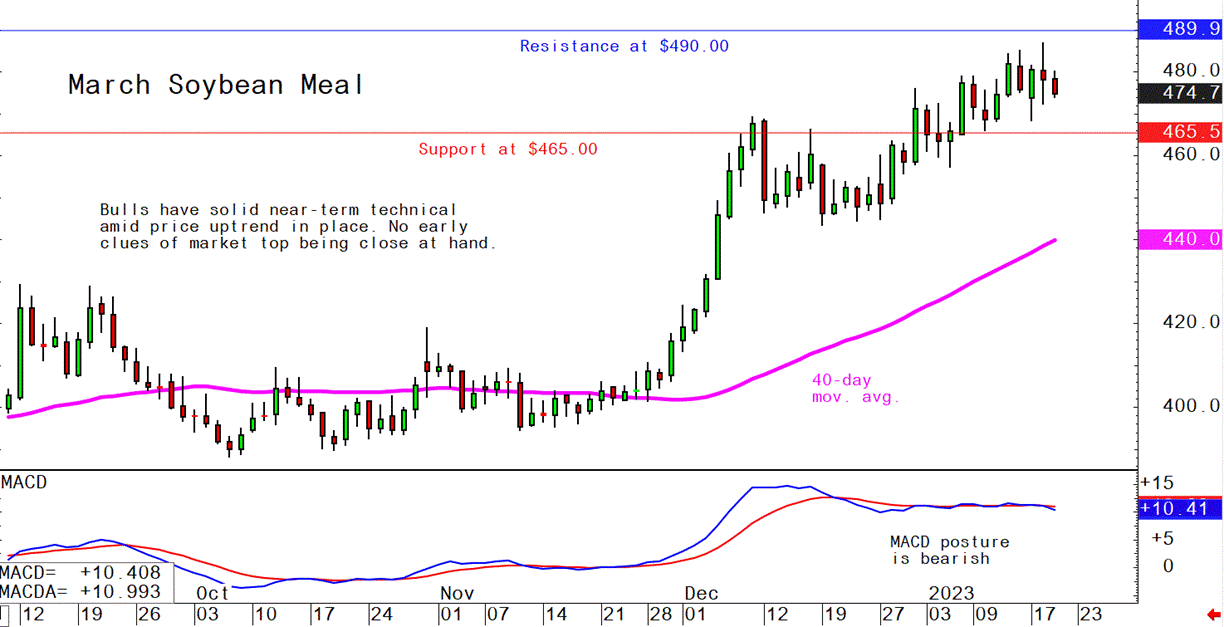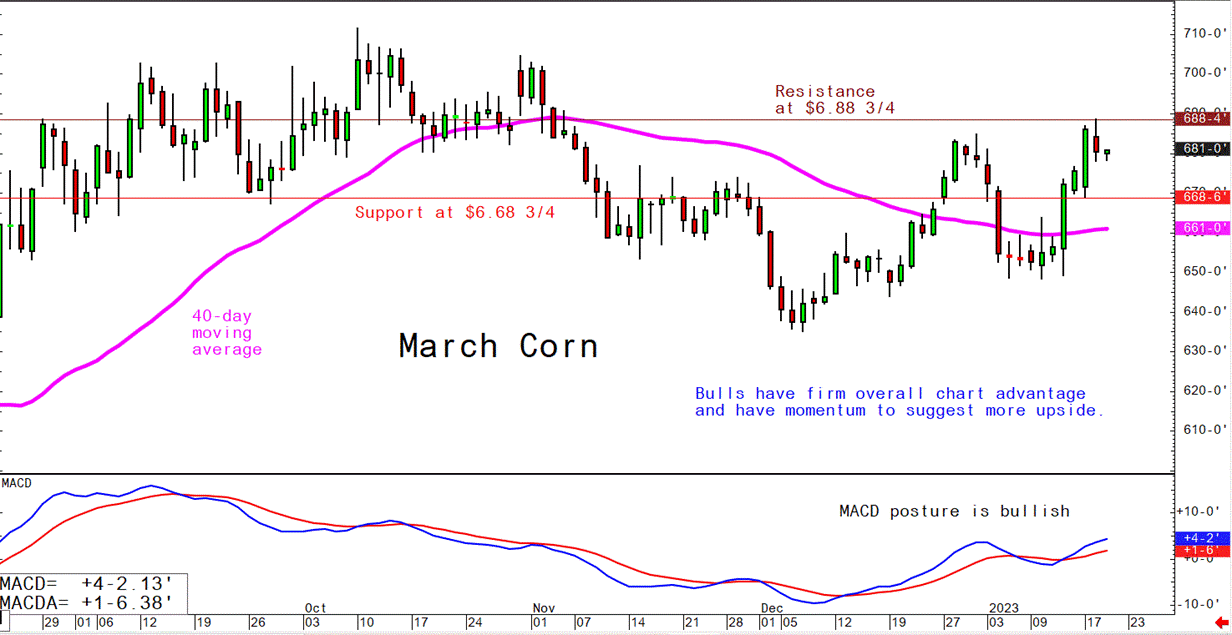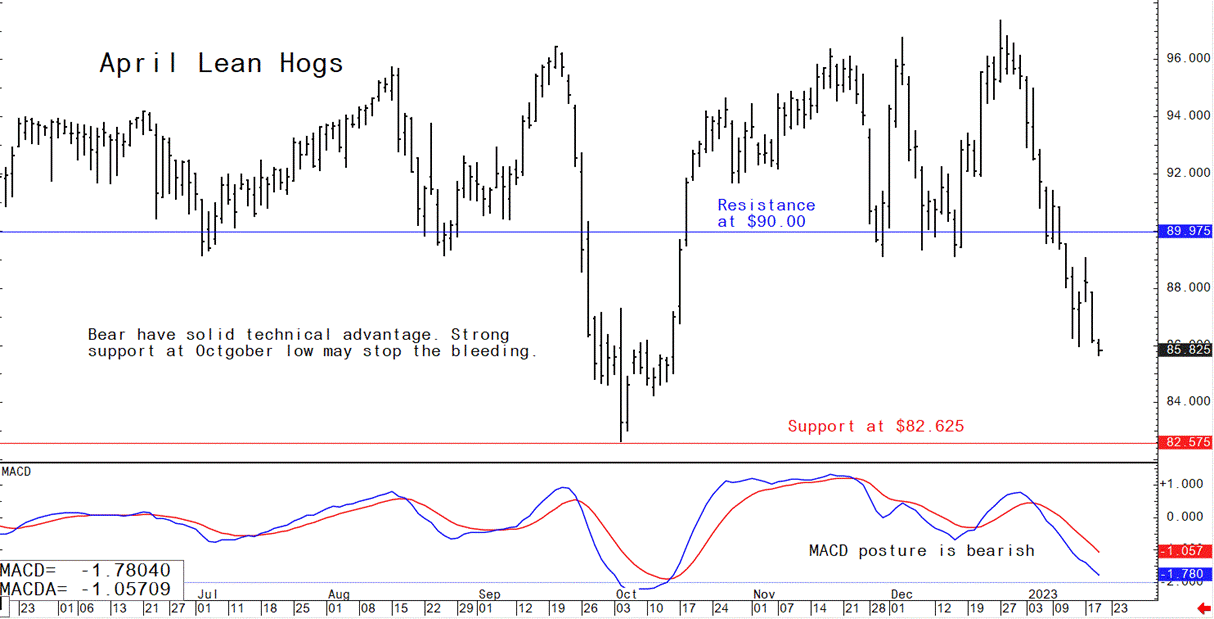



Pig outlook: The bleeding continues in lean hog futures, plus China, China, China
Analyst Jim Wyckoff shares an update on the US futures market, USDA reports and global pig newsLean hog futures prices this week extended the steep downdraft as prices hit three-month lows. There is strong chart support at the October lows that will likely halt the price declines.
The lean hog futures bulls point out that retailers are buying a lot of pork. US packers moved 388.1 loads of pork on Wednesday, bringing this week’s volume to 1,253.5 loads. Wholesale pork prices are cheap compared to beef. The CME lean hog index continued its recent drop.
The backlog of hogs on US farms created by extended packer cutbacks through the holiday season remains a force driving hog prices lower. Still, the tight numbers and low weights that dominated the hog market late last year, as well as the 2% year-to-year hog supply reductions implied by the USDA’s December Hogs & Pigs report, suggest a recovery in hog prices soon.
China’s December pork imports largest since November 2021
China imported 200,000 MT of pork in December, up 20,000 MT (11.1%) from November and 20.1% greater than last year. For 2022, China imported 1.76 MMT of pork, down 52.6% from the previous year.
China to buy pork for state reserves after holiday
China will organize purchases of pork for state reserves after the Lunar New Year holiday, an ag ministry official said.
China’s sow herd above ‘reasonable’ level
China’s sow herd at the end of 2022 was slightly higher than a reasonable level at nearly 44 million head, an ag ministry official said. “We... hope that the majority of farms will stabilize the number of high-quality reproductive sows and take early measures to deal with the downward price of pigs,” the official said. The official also said China’s hog slaughter increased 18.3% from November and 7.3% from last year in December.
China’s 2022 pork production hits eight-year high
China’s pork production increased 4.6% last year to the highest since 2014, official data showed. Pork output reached 55.41 million MMT in 2022, up from 52.96 MMT in 2021 and the highest since 56.71 MMT eight years ago. Pork production totaled 13.91 MMT during the final quarter of last year. China’s beef output increased 3% to 7.18 MMT in 2022, the data also showed, while poultry production rose 2.6% to 24.43 MMT and lamb and mutton output increased 2% to 5.25 MMT.
China’s meat imports continue to climb
China imported 700,000 MT of meat in December, up 30,000 MT (4.5%) from November and 7.7% greater than last year. China’s preliminary data doesn’t break down meat imports by category, but the steady increase since late summer has been due to higher pork imports. For 2022, China imported 7.4 MMT of meat, down 21.0% from the previous year.
USDA reports on world livestock trade
USDA says despite the challenges of the current wave of COVID-19 infections in China, the import forecasts of beef and pork in 2023 are revised up and are now forecast higher year-on-year. However, chicken meat imports are forecast marginally lower. The upward revisions for China red meat import forecasts are partially derived from higher estimates for 2022 as fourth quarter shipments were stronger than expected.
For 2023, projected economic recovery as well as the anticipated revival of the hotel, restaurant, and institutional (HRI) sector support expanding consumption and red meat imports. Despite an upward revision for China pork production in 2023 from the October forecast, domestic supplies are virtually unchanged year on year and are unlikely to fully meet rebounding consumption.
Beef imports are expected to grow in 2023, but the pace of shipments will slow as importers have product in cold storage that needs to enter the market before they will invest in additional purchases. China chicken meat imports are revised lower to pre-pandemic levels. Lower pork prices are expected to lower consumer demand for chicken meat. However, chicken meat imports account for only about 4 percent of consumption. Global beef production for 2023 is virtually unchanged from the October forecast at 59.2 million tons.
Global pork production for 2023 is revised up 3 percent from the October forecast to 114.0 million tons on higher output in China. Pork demand is expected to strengthen in China due to recently lifted COVID-19 restrictions.
Production forecasts remain largely unchanged for other countries. Global pork exports for 2023 are forecast 2 percent higher from the October forecast to 10.7 million tons as EU, Brazil, and U.S. exports are up on stronger than anticipated demand from key Asia markets. Upward revisions in China and Philippines imports will more than offset a decline in the United States. Philippines imports are forecast higher as reduced import tariffs for pork are extended through 2023. African swine fever continues to stifle Philippines production, boosting demand for imports.
USDA January monthly supply and demand report (WASDE)
LIVESTOCK, POULTRY, AND DAIRY: Red meat and poultry production for 2022 is lowered from last month as higher broiler and turkey production in the fourth quarter is more than offset by lower beef and pork. Changes reflect November production data and preliminary estimates of slaughter numbers and weights for December. Egg production is lowered slightly based on production and flock data.
For 2023, the beef forecast is raised with higher expected slaughter of steers and heifers, as well as cows and bulls. This increase is slightly offset by lower carcass weights. USDA’s Cattle report, which will be released January 31, will provide an indication of the number of cattle available for placement during 2023 as well as producer intentions for retaining heifers for addition to the breeding herd.
Pork production is raised reflecting pig crop data for the second half of 2022 and producer intentions for sow farrowing in the first half of 2023. Broiler production is reduced for the first quarter based on recent hatchery data. Turkey production is raised for the first quarter based on hatchery data. Egg production is reduced on a slower expected pace of recovery.
Beef export estimates for 2022 are lowered and imports are unchanged on recent trade data. For 2023, beef imports are raised, largely on higher expected imports from Brazil, but the export forecast is unchanged. Pork imports for 2022 are lowered, but exports are unchanged. For 2023, pork imports are lowered, but exports are raised. Broiler exports in 2022 are raised on recent trade data, while 2023 exports are lowered. Turkey exports are lowered for both 2022 and 2023. Price estimates for 2022 are adjusted to reflect December data.
For 2023, cattle prices are raised on expected strength in demand for fed cattle. Hog prices are raised in the middle quarters of 2023 reflecting demand strength. Broiler prices are projected lower as weaker prices in late 2022 are expected to carry over into 2023. Turkey and egg prices for 2023 are raised on recent prices and expectations of continued firm demand and tight supplies.
The next week’s likely high-low price trading ranges:
April lean hog futures--$84.00 to $90.00 and with a sideways-lower bias
March soybean meal futures--$465.00 to $490.00, and with a sideways-higher bias
March corn futures--$6.65 to $7.00 and a sideways-higher bias
Latest analytical daily charts lean hog, soybean meal and corn futures










